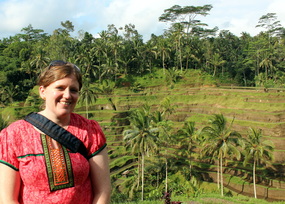 My final international adventure while living in Korea was also one to which I was truly looking forward. As so many people do I have a "bucket list" of sorts, a series of things I'd like to do during my lifetime. Bali has always ranked pretty high on that list. Photos of the Indonesian island drew me in with lush green rice paddies, shimmering blue waters and Hindu culture. When I pondered where to go during my summer vacation naturally I thought of Bali and quickly booked a plane ticket and started planning out my trip. Though I spent a significant amount of planning out this final adventure I almost missed out on it. Preoccupied with making arrangements for this "last hurrah" I incorrectly remembered the departure time of my flight. By the time I realized what I had done I had approximately 3 hours to get to Incheon Airport, a journey that easily takes 2+ hours from Jeomchon, on a good day. This particular day was a Sunday which typically boasts more traffic in/out of Seoul in addition the weather not cooperating with sporadic rain showers. Fortunately Marize, a fellow waygookin in the area agreed to take me. I will forever be grateful to her - it was truly one of the kindest things anyone has every done for me. We arrived at the airport with just 30 minutes to spare and I was able to check in and get through security and make my plane. My goals for the trip were to relax, try a variety of Indonesian dishes and explore the Hindu culture of Bali. Overall I was able to achieve those goals and I think it was a successful trip but for some reason I didn't love Bali. Perhaps it was because I felt like a walking dollar sign throughout the trip - I had an especially bad experience at the Mother Temple of Besakih where a government employee harassed me continuously to hire him as a guide and I ended up leaving. I suspect that some of my disappointment also stems from the fact that Bali was one of my ideal vacation locations and it just didn't live up to the hype - it was overly touristy and catered to a type of traveler with which I do not encompass. Another factor was that I was truly looking forward to the familiarity of its Hindu rituals only to discover that the Hinduism of Bali was far removed from those of the Indian subcontinent - I honestly don't know if Indians would recognize the rites and rituals as Hindu. However, there were highlights during the trip like the colorful Barong performance, an incredible cooking class, the lush green scenery, gentle warm breeze and an extended day at a spa. And of course I ended up with a variety of handmade good which now decorate my apartment.
0 Comments
I recognize that I can be a bit loquacious and not everyone wants to sit down and read a lengthy description of someone else's vacation - blogs have replaced the boring slideshows to which travelers once subjected their friends and family. So I compiled a selection of photos from my trip - a snapshot from a favorite moment or simply a photo which I think represents some aspect of the country I visited or the trip itself. A few of the photos are repeats from the blog entries but many are candid shots from my trips to the countryside.  It was not by accident that my last stop on my whirlwind south east Asian adventure was Cambodia. I decided to end my trip there for two reasons - 1) I knew my last few days of travel would be the highlight of my trip because I absolutely love Cambodia and 2) since I had already been there once I was going to be able to relax and spend more time visiting a couple of favorite spots as well as a few new ones. Cambodia, a small country nestled between Vietnam, Laos and Thailand is probably best known for the grandeur of Angkor Wat, an architectural marvel, and the heart breaking legacy of the Khmer Rouge, which I saw first hand during my brief stay in Phnom Penh. As with my first visit to Cambodia this trip was woefully too short - how I wish Cambodia had the same lucrative ESL positions as Korea and Japan so I could live in such an intriguing country while also paying down some debt. Since it's unlikely that will ever happen I guess I'll just have to look forward to a return visit sometime in the future. Phnom Penh  Though I had visited Cambodia before my first trip centered around the ruins in and near Siem Reap. I only spent a mere hour or so in Phnom Penh while changing buses. On this trip I decided to visit the small city and so I scheduled 1 1/2 days there. Regretfully this was much too short and the next time I return to Cambodia I will have t o spend a bit longer in the city so I can become more familiar with it. After arriving in Phnom Penh and settling into the hostel my first destination was The Killing Fields, an area outside of the city. The Killing Fields were so named because it was one of the locations where soldiers for the Khmer Rogue killed so-called "enemies of the state" - typically people whose education the government deemed dangerous to its agriculture based society. Below I've posted photos and more information about my visit there. The rest of my time in Phnom Penh was spent walking around, taking a cooking class, observing Khmer memorializing their king who had passed away a few months before and riding in a tuk tuk so I could see different parts of the city. The city itself was dusty and dirty but the people I encountered such as those in the hostel, the cooking instructor and my tuk tuk driver were friendly and warm. The Killing Fields In the mid-1970's the Khmer Rouge, a communist party in Cambodia, took power of the country and tried to force the population into its own skewed concepts of a proletariat paradise - an agricultural society without intellectuals, cities and the arts. The Khmer Rouge emptied the cities and forced people to return to the countryside where they were expected to farm the land and adhere to the strict policies of the controversial government. In an effort to cleanse the population of perceived dangers the Khmer Rogue tried to wipe out intellectuals, people associated with the former government and any foreign governments, immigrants from Vietnam, Thailand and the likes as well religious followers including Buddhist monks and Christians. An estimated 2 million people died during the 4 years the Khmer Rogue were in power which doesn't even take into account the atrocities against women or the children removed from their families never to see them again. There are many killing fields in Cambodia, areas where people were executed and then buried in mass graves. The most famous is near the village of Cheoung Ek outside of Phnom Penh which is where I visited during my most recent trip to Cambodia. The Killing Fields memorial outside of Phnom Penh has a disquieting beauty. From first glance the green landscape, the tall Buddhist stupa, the quiet pond and Cambodia's sunny blue skies give the impression of a local park however instead of the laughter of children one only hears silence except for the occasional murmur of a tour guide explaining the horrific actions that in the not so distant past took place there. Each visitor is given an audio guide to listen to while walking around the memorial. The audio guides are available in a plethora of languages perhaps indicating the diversity of tourists that visit there or maybe because the Cambodia people are desperate for their story to be told in order to prevent the horrors of the Khmer Rogue happening again. The audio guide which leads people through the area details what exactly occurred at the Killing Fields years ago - testimonials from people who had lived through the Khmer Rogue are given. Survivors talk about witnessing executions, women talk about the horrors and shame of being raped and even a former guard speaks about the things he was asked to do or that he saw. During some of my travels I visited sites that are testament to the horror that humans can do to one another. I witnessed the skeletal remains of Jewish prisoners at the concentration camp of Dachau, saw photographs of death and deformities caused by the a-bomb at the Peace Memorial in Hiroshima and met a woman in Vietnam who, as a child, was one of the few survivors of the rape and murder of a dozen women at the hands of soldiers during the Vietnam/American conflict. I had the same emotional and visceral reaction to The Killing Fields as I did to those other locations. However, at The Killing Fields the memories of the terror there literally are coming up out of the ground as it is not uncommon for visitors to come across pieces of human bone along the paths. While the entire memorial is a disheartening ode to the evils of man the sign that was the most disturbing, the place that I suspect most visitors shed a tear was the one pictured below. The tree above was used by soldiers in the Khmer Rogue to beat to death children in order to save bullets. Bracelets were left in memorial of the children. In a spirit house nearby a visitor left a simple origami crane, a symbol of peace in Japan which one can find by the thousands at the Peace Memorial in Hiroshima. And inside that beautiful stupa pictured above? The bones of hundreds of people found buried in the mass graves at the Killing Fields, a tragic reminder of how cruel people can be to one another. Siem Reap  After an emotional albeit too short time in Phnom Penh I woke up early one morning for the long drive to Siem Reap. Compared to the van ride in Thailand this one in Cambodia was positively spacious (it helps when you don't have your backpack on your lap). The van drove along highways and dirt roads and often through small towns giving passengers a glimpse of different sights throughout Cambodia. In the early afternoon, nearly 6 hours after leaving Phnom Penh we pulled into the local stop in Siem Reap and I hopped into a tuk tuk waiting for me and headed to my guesthouse. After a quick meal I headed out to check off a few items on my list of must-dos when I returned to Cambodia. During my four days in Siem Reap I re-visited a few of my favorite temples, spent part of the day in the countryside learning about the life of rural Khmer, enjoyed a dance performance which was based on the ancient dance form of apsara, pampered myself with a couple of spa treatments and visited a silk farm where I learned the exorbitant amount of time and effort it takes to make something as simple as a scarf. Beyond Siem Reap 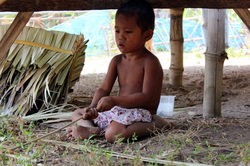 During my first visit to Cambodia I had the opportunity to visit Kompong Khleang, a remote rural village where foreigners are a rarity. I still remember the smiles and shouts of the local children who came out to see my travel partner and me. That experience remains one of my most memorable from all of my travels. On this visit to Siem Reap I was interested in another experience away from the tourist saturated temple ruins. While flipping through a guidebook for the area I happened upon an ad for Beyond. Unique Escapes, a tour company that organizes socially responsible trips. After a brief visit to their office I decided on their country side tour where participants would learn about the lives of the average rural Khmer and take part in some type of volunteer work. The goal of the volunteer work was to assist a type 1 family - a family with no consistent source of income nor without any savings, one which typically struggles to eat daily. Early the next morning I joined 3 other travelers and 2 guides and we drove outside of Siem Reap until all we saw were rice paddies and homes constructed of thatch. When the van finally stopped we hopped out then got into carts pulled by bullocks for a brief tour of the area. Our assigned work for the day was to weave thatched panels for a family home. Homes made of thatch need to be re-done every few years because the building materials begin to deteriorate from the elements. The process can be lengthy - first the leaves must be collected, dried, then soaked in the pond before being dried again in the sun and then family members begin to weave the panels. However, it was slightly more difficult for this family because the mother had recently given birth and she was busy caring for her new born baby. After a brief tutorial we began to weave our panels which proved to be slightly difficult due to the stiff nature of the material and the dullness of the makeshift needle. It was an interesting experience but sadly quite short - we only wove the panels for an hour before a brief tour of the nearby rice paddies while the guide told us more about the daily lives of the local people. After returning to our starting point the guide showed us how to make a couple of local dishes, one of which was a type of steamed salad with red ants as a main ingredient. We sat down in a clearing and enjoyed lunch before bidding farewell to the family we were there to assist and walked back to the central point of the village which had a small temple and school. Altogether it was a good experience and worth the $30 dollar fee (part of the money went to the family as well as a village fund) though I wish we had been able to spend more time helping the family or getting to know them. I realize it was most likely awkward for the women to have strangers at your home who didn't speak your language and were privileged simply because of the countries in which they were born so I understand the limited interactions. However, I do believe we could have woven more panels since the tour ended a few hours earlier than scheduled. The Temples of the Khmer Empire 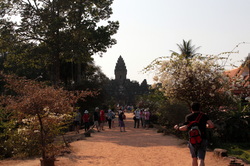 The biggest draw to Cambodia are the plethora of ancient temples which are scattered around the city of Siem Reap. The most famous is Angkor Wat, a temple which is nearly a millennium old and is the largest Hindu temple in the world. However, Angkor Wat is not the only temple in the area worth visiting - Bayon boasts dozens of carved faces of a Khmer king, Banteay Srei delights visitors with its beautiful red sandstone while Ta Prohm highlights the balance between nature and the temples. Upon my return to Siem Reap I decided to visit a selection of my favorite temples - The Roulous Temples, Banteay Srei, Ta Prohm, Bayon and ultimately Angkor Wat. This experience was a bit different from my previous visit - in June of 2009 there were minimal tourists at the sites and I even managed to explore the Roulous temples in solitary. However, February seems to be a popular time for tour groups from far east Asian countries and I had a vastly different experience this time around amongst the hundreds of other tourists all clamoring for the same photo op. I guess an upside of the increased number of tourists is that the hawkers outside the temples concentrated more on the tour groups than the individual travelers so for the most part I could get into and out of the temples without receiving the hard sell to buy some small trinket. Though I had to fight the crowds to see the temples I still marveled at the incredible architecture and detail of the Khmer temples and below are a few photos from my visit. 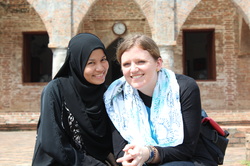 My Malaysian adventure ended with a short flight from Kuala Lumpur to the southern Thai city of Hat Yai. Thailand is a country which I doubt I need to really introduce - it's probably the most well known country in south east Asia because of its incredibly popular food, beautiful architecture and friendly people. Once the plane I was on touched down I began the surprisingly easy journey from there to the town of Pattani. I had expected this portion of my trip to be a bit more difficult since this part of southern Thailand isn't exactly known for being a tourist destination and therefore fewer people speak English. However, my friends had given me wonderful advice and I easily transitioned from the airport to the bus station via taxi and from there in a van full of university students to Pattani where I traveled to for a mini reunion with fellow BSU students. I split my time in Thailand between Pattani in the south and Chiang Mai in the north - this permitted me to see two distinctly different aspects of Thai culture - the Malay Muslim influenced culture of the south and the Buddhist centered culture of the north. Pattani  Approximately 2 1/2 years ago I met a trio of Thai students through my job at the Rinker Center for International Programs at BSU. We saw each other at different events and two of them even presented on Thailand at the Culture Exchange series that I coordinated for the department. Over time we got to know each other better and they joined the occasional international dinners at my apartment, we had dinner together at the local Thai restaurant and before they left they cooked a delicious Thai meal for myself and a few other RCIP employees. After they returned to Thailand we kept in touch through messages and posts on facebook. When I moved to Korea I knew it would only be time before I visited Thailand - and last January I found myself in a hot crowded van on the way Pattani to see them. Below is a photo with me, Mareekee, Arseeya and Nurhakeema (and her daughter). Pattani was the biggest detour from the typical tourist circuit of South East Asia during my trip. Not many tourists make it to this part of Thailand. The area boasts a large ethnic Malay Muslim population in contrast to the rest of Thailand which is predominantly Buddhist. The state of Pattani is unfortunately a bit infamous in Thailand and abroad due to civil unrest that manifests itself in the occasional bombings (the most recent was approximately 5 months before my visit). If I understood my friends correctly the radicals who set off the bombs do so because they want the state of Pattani to be part of Malaysia with which the population shares more in common including language, culture and religion. My friends showed me around a bit - taking me to a local mosque, an old Chinese mosque, a local night market and a popular barbecue restaurant. In between those trips I explored Pattani on my own or hung out with them enjoying a mountain of fresh fruit at the local English school that Nurhakeema and her husband own and at which Mareekee and Arseeya work. Pattani doesn't have a lot of designated points of interest but it is a decent sized town and so each day I would wander around. Since it is an unlikely tourist destination I discovered when I walked around town that I created quite a stir - people stopped to stare at me, a falang (foreigner) and children chased after me to yell 'hello'. Chiang Mai 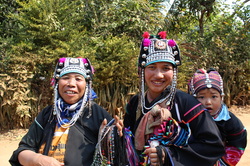 While I was sad to leave my friends behind in Pattani I was incredibly excited for the next stop on my journey - the beautiful city of Chiang Mai. Located in the northern part of Thailand the city is hailed as a cultural center for Thailand with a plethora of restaurants (Thai and foreign), glittering Buddhist temples on each block, extensive night markets, local elephant training camps and settlements of hillside tribes. Northern Thailand was exactly what one might expect of the country - sunny blue skies with lovely 80 degree weather, saffron robed monks walking along the streets and extravagant temples nearly everywhere. What I hadn't expected was the images of Ganesha (a Hindu god) I found throughout the city - whether outside of Buddhist temples positioned next to a statue of a Buddha or on a poster hanging on the wall of a business. My last morning in Chiang Mai I made my way to the small Hindu temple in the city where I spoke briefly with the Indian priest who told me that many of the regular devotees were in fact Thais themselves. The Karyan, Akha and Others In addition to exploring temples I also took a day trip outside of town to meet some of the ethnic hilltribes including women of the well-known Karyan long neck tribe. Though the trip itself was a bit superficial at times with the guide herding us out of and into the van for brief encounters with people from the different ethnic groups, some of whom pressured us heavily to buy their goods, it did give me brief opportunities to speak with, albeit limited by language differences, some of the women. Those short chats were one of the highlights of my overall trip.  After less than 48 hours in Singapore I hopped on a comfy private bus and crossed the border into the neighboring country of Malaysia. Malaysia is a small country in south east Asia which is split between the Malay Peninsula and the island of Borneo. I only had 6 short days in Malaysia so I decided to split my time between the cities of Melaka and Kuala Lumpur. Melaka  My first stop in Malaysia was the small city of Melaka, a UNESCO World Heritage site. The city, at one time a vibrant port city, showcases its cultural diversity through intimate ethnic neighborhoods, architecture and food. The focal point of the historic part of town is the Red Square, a cluster of red brick buildings built by the Dutch. The square is situated near a meandering river which is bordered by restaurants and bars in converted merchant buildings.Since I arrived in town on Monday I missed the weekly night market which draws large crowds every weekend. Instead I discovered that during the week the historic district of Melaka is eerily quiet with most restaurants closed by early evening, if open at all.This was a bit frustrating since the restaurants in this area were more likely to have vegetarian fare. Thankfully there was a small hole-in-the-wall that catered to the local Indian population which is where I ate a couple of different meals. My visit to Melaka was relatively quiet and laid back - a nice adjustment after the hustle and bustle of Singapore. While there I enjoyed visits to the local Hindu temple, a boat ride down the river, a tea appreciation class, a small selection of vegetarian food and a beer or two while sitting near the river. Kuala Lumpur  After a few quiet days in Melaka I packed up my bag and hopped on another bus for a trip to Malaysia's bustling capital city - Kuala Lumpur. In Kuala Lumpur I met up with Lina, a Malay woman living in the city. We had met via couchsurfing.org, a website that aims to connect travelers and locals. Lina was kind enough to offer to show me around the city and we spent the next two days exploring all it's different sites including the Batu Caves, the national mosque, the national museum and Patronas Towers. With the help of Lina's language skills I was also able to try a variety of tasty Malay dishes including the incredibly spicy and sour assam. While the Batu Caves was the highlight of my short visit to Kuala Lumpur (which I detail below) the visit to the national mosque was a unique and eye opening experience. The mosque is only open during set time periods for non-Mulism visitors and the dress code is strictly enforced. If a woman is not fully covered she must wear an abaya, a loose flowing gown, and all women must wear a hijab, a head covering (see the picture below). Men also are required to wear modest dress though they are not required to cover their heads. The mosque itself is a beautiful building with an interesting syncretization of traditional Islamic cultural elements and Malay design integrated into a sleek and modern building. Within the building we observed people praying and a classroom full of children singing verses from the Qur'an. Batu Caves  My favorite part of my trip to Malaysia was a morning visit to the Batu Caves. Located on the outskirts of Kuala Lumpur the Batu Caves are a sacred site for the local Hindu population. Inside and around the caves are Hindu temples dedicated to Murugan, Siva and other deities. One of Malaysia's largest annual festivals is held at the caves - Thaipusam, a popular Tamil festival which draws thousands of Hindus to the Batu Caves. Visitors to the caves walk there from the train station along a road with stalls set up selling Indian sweets, garlands of flowers and fresh coconuts. Once you arrive at the entrance you need to climb nearly 300 steps to get to the caves themselves and visit the temples inside. Meandering amongst the tourists and devotees are wild monkeys which I was told are attracted to the crinkly sound of plastic bags and will snatch them from visitors in order to consume the contents. Our visit to Batu Caves permitted me to observe disaporic Hindus practicing their religion. I was even welcomed by the priests to participate in aarti and archana and was blessed by the priests at different temples. As you know from previous posts I recently went on a month long trek through south east Asia. Before I left on my trip I was a bit nervous about all the things going wrong on an extended trip such as that - especially since I was a female traveling alone. However, once I started my adventure and got into traveling mode all my worries melted away and I had a great time. There were definitely a few highlights to the trip and I'll write a post about them after I upload a few photos from each country I visited. It probably will take some time to get everything uploaded and posted but I'll try to do it sooner rather than later so I can also post a few entries about life in Korea. Below are a few photos and experiences from my first stop - the city/state of Singapore. Singapore  Singapore has the distinction of being the first English-speaking country I've ever visited outside of the USA. I'm fortunate to speak the language that is the current international language of business and travelers so traipsing around foreign countries is a bit easier for me than say, the Russian family I met in Laos with limited English. However, I guess I've just grown accustomed to some of the communication issues when traveling abroad because it took me awhile in Singapore to realize it was so easy to get around. Signs are in English (with Chinese, Malay and Tamil translations) as were menus and nearly everyone I encountered spoke English fluently. I think I'll definitely have to add a few more English speaking countries to my travel itinerary for the future because it was wonderful to be able to communicate easily and effectively. I only spent a day and a half in Singapore because the country is incredibly small (it's a city-state) but very expensive in comparison to the rest of south east Asia. I focused most of my time there on two areas of interest - flowers and Indian culture. I spent most of Sunday exploring the beautiful Botanic Gardens and later on in the vibrant Little India neighborhood. Singapore Botanic Gardens 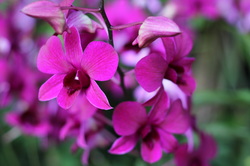 Located in the city sits the 183 acre Botanic Gardens. The gardens offer refuge from the hustle and bustle of the city enticing visitors with its lush grassy lawns, quiet lakes and intriguing public art. For me the highlight of the gardens was the orchid garden - a small section of the larger gardens which boasts a variety of brightly colored orchids. I spent a couple of hours in the garden Sunday morning and relished not only the beautiful flora but also seeing the locals enjoy and take advantage of all the garden has to offer - something that reminded me of Chicagoans and the lakefront. Little India  Singapore is a diverse country with a population made up mostly of Chinese, Malay and Indians. One of the reasons I wanted to visit Singapore was because of it's large Indian population. My research was on diasporic Hindu traditions in the United States and I was curious to see how Hinduism was praticed in other countries. Unlike in the United States where the majority of Asian Indians are highly educated relatively recent immigrants who are employed in professional jobs the Indian community in Singapore dates back over a hundred years and inhabits a variety of socio-economic roles. Though I was there only for a day and a half I managed to visit 3 different temples and observed that Hinduism in Singapore was practiced much more closely to its Vedic roots than it is in the USA. I spent part of Sunday in Little India - enjoying some really tasty food, peeking in to shops and visiting temples. The neighborhood was almost exclusively Indian and the smells and sounds were reminiscent of India which I traveled to last year. Sri Mariamman Temple  Of the three temples I visited Singapore's oldest temple, the Sri Mariamman Temple, isn't located in Little India but instead on the periphery of Chinatown. I visited this temple multiple times during my short visit to Singapore because of it's close location to my hostel. I was able to observe the priests conducting a daily ritual in addition to people worshiping at the temple. The experience gave me a different perspective on diasporic Hinduism which is useful for my own research.
For a small fee you can take pictures throughout the temple which was elaborately decorated with statues of animals and gods. The temple is unlike something most people in the U.S. have seen so I wanted to share a few photos. 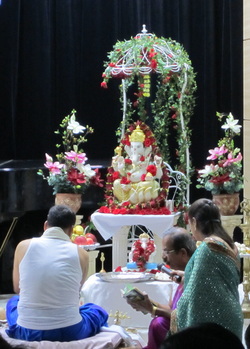 After a year in Korea I've finally found the information network for the local Indian community. It turns out that most Indians keep in touch via a facebook group. I requested to be added and now I am privy to the announcement for events such as Ganesh Chathurthi.
Ganesh, for those of you who don't know, is one of the most recognizable Hindu gods with his elephant head and body of a human. He's incredibly popular in Hinduism because he helps the devotee overcome obstacles so many Hindus pray to him before starting something new. Ganesh Chaturthi is an annual event that honors Lord Ganesh. Since my research has been with diasporic Hindu traditions and with the conclusion of my current job and the start of my new one I decided it would be auspicious to attend the event. I left quite early Sunday morning for Seoul and arrived at the beginning of the ritual. It was interesting to observe the puja (religious ritual) after spending so much time within an established Hindu community in the US. The man conducting the puja didn't seem to be a priest by trade and paused here or there to adjust things during the ceremony. After the puja was complete the rest of the morning and into early afternoon was filled with cultural events - mostly singing and dancing and the occasional discourse. The entire event was being hosted by the local Hare Krishna temple and this sponsorship was evident in the discourse given. One man called for people to share the Vedic culture with non-Hindus, a type of prostelyzation of which I had never heard before in a temple (or amongst Hindus). Another man spoke at length about how one might define religion and gave a very outdated perspective of how religion is understood within academia. It was an interesting event - one that I'm happy to have attended to have a better understanding how some Hindus continue to carry on their traditions and rituals in a country such as Korea. 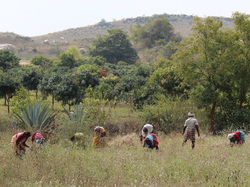 I arrived in Bangalore late Saturday evening and after collecting my baggage and making my way through immigration I passed through the sliding doors separating the restricted section of the airport and the general public where I encountered a breeze of fresh warm air. Though it was well after 10pm at night the airport was still abuzz with people and so it was a bit difficult to find my friend and her mother who I was meeting. Chaitanya and I know each other from graduate school back in the US. We met through the friendship family program at our university, which at the time I coordinated. Familiar with the difficulties and isolation of living abroad I wanted to help ease the adjustment of international students into life in America. Chaitanya was the first of many friendship students while I was at BSU but she also was the one I grew closest to and eventually our relationship transitioned from friendship family into good friends. Therefore when she invited me to India to attend her wedding I immediately began to research the possibility and was thrilled when received my visa and could plan a trip to the subcontinent. After meeting up with Chaitanya, her mother and family at the airport we began the 3 hour drive back to their town. The sky was pitch black and the air was warm and dusty. At one point we pulled off the road due to a flat tire and while they changed it Chaitanya and I wandered to a small stand where we purchased fresh green coconut. The elderly woman lopped off the top and stuffed in a straw and we both slowly sipped the slightly sweet taste of coconut water. As we stood along the side of the road under the dark sky enjoying the refreshing drink with a cool breeze causing me to feel chilled I realized I really was in India. I have always planned on traveling to India but I imagined my first visit to extend for months or even years when I moved to India for research. However, now I can see that those two brief weeks in Andhra Pradesh were the perfect introduction to the beautiful chaos that embodies India. Below are a few highlights of my trip. 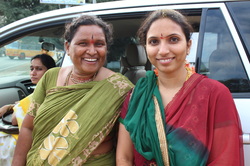 The People India is as welcoming as it is colorful. In the short two weeks I was there I experienced more hospitality than in all the months I have lived in Korea. People were incredibly kind and gracious - though by Western standards they did not have much and we were separated by a difference in language I was welcomed into their homes where they were eager to feed me, talk to me and share their lives with me. I am most thankful to Chaitanya's family who opened up their home to me for the two weeks I was there - they fed me, cared for me and tolerated my quirky Western ways. Though we relied on Chaitanya to translate for us her mother and aunty's incredible warmth transcended the language and cultural differences. The friendliness and warm-hearted nature of the Indian people has made my adjustment back to my more subdued life in Korea a bit difficult. It seems India is a better match for me personally than Korea. 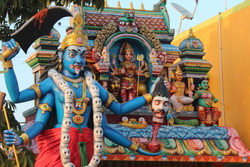 MahaKali Our trip to Kanchi in Tamil Nadu was a blur of color where we spent hours looking over thousands of yards of brightly hued intricately woven silk sari. However, for me, the highlight of the day was a stop at a Kali temple alongside the highway on our way home. I have been interested in studying goddess worship, specifically of Kali for years. Earlier in the day I was not permitted entrance into another goddess temple because I was a foreigner and therefore the inclusive nature of the temple priest at this mandir was especially meaningful. He allowed us into the room with the murti of the goddess and chatted with us for a brief time before blessing us as we left. I was joking when I declared at the temple it was the highlight of the trip at that moment but even now it stands out in my memory.  A Pilgrimage I've been studying localized practices of Hinduism for a few years now and I was determined to see as many temples as possible on my trip to India. I am thankful to the Rao family, neighbors of Chaitanya's parents, who invited me along for a day long pilgrimage to 5 different temples throughout Karnataka and Andhra Pradesh. The temples were dedicated to Lord Siva, Sri Venkateswara, the goddess, Ganapati and Hanuman-ji - at each one the family sponsored archana, a short ritual led by a priest. This experience gave me a new perspective on Hindu temple worship and the ability to observe the differences not only between temples in the United States and India but also between temples within India. 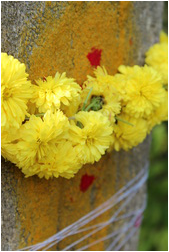 Puja
The days leading up to a Hindu wedding involve a plethora of events and I had a up close and personal view of all of them. I was incredibly honored to not only observe but also participate in so many of the important rituals leading up to and subsequently during the wedding. I accompanied the family to the Ganesha temple where we prayed for new beginnings, I offered advice during sari shopping and was completely mesmerized by the glittering gold in the jewelry shops. I nervously smeared turmeric onto Chaitanya's face during one ritual, afraid I'd ruin her sari and I poured grains of rice over the bride and groom's head and offered well-wishes during the engagement party. In other words I was there alongside other family and friends, an active participant in the events - this is how I enjoy to travel - not as an outsider but as someone embraced within the culture by the people around me. It truly was a memorable trip. Indian weddings are as colorful as India herself and are in stark contrast to the austere nature of weddings in the West. They are a lively mixture of bright hues, cacophonous noise and ancient rituals. I was fortunate to have been invited to partake in many of the different activities and rituals leading up to the wedding in addition to portions of the actual ceremony. It was an incredibly memorable experience which I will forever be thankful to my friend and her family for welcoming me into their home and including me in such an important event. Visit the India page under the Globe Trekker tab (or click here) to see more pictures from the wedding and my experiences in India.
 It's a testament to how much I enjoyed my research and how welcomed I felt by the Hindu community that, though I initially planned on only visiting the temple for a few hours during my final visit to Munice, I actually ended up spending the entire weekend there.
Though I felt prepared by years of classes in anthropology when I entered the community to do research I realize now that what they don't prepare you for is when you leave. It's difficult to say good bye to people who overwhelmed me with kindness during my time there and all I can say is a heartfelt thank you. |
| Mindy in the City |
|
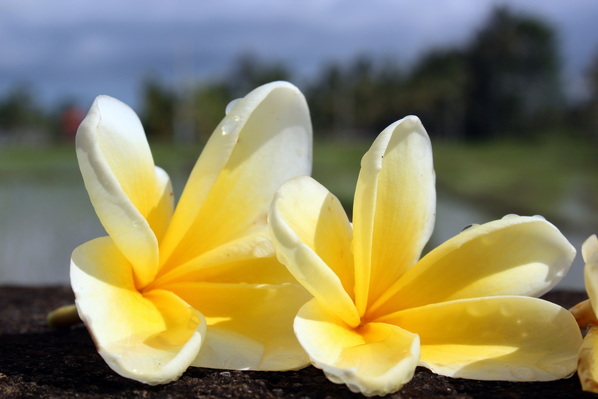
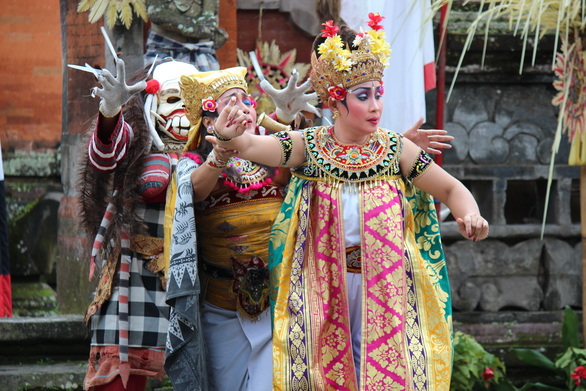
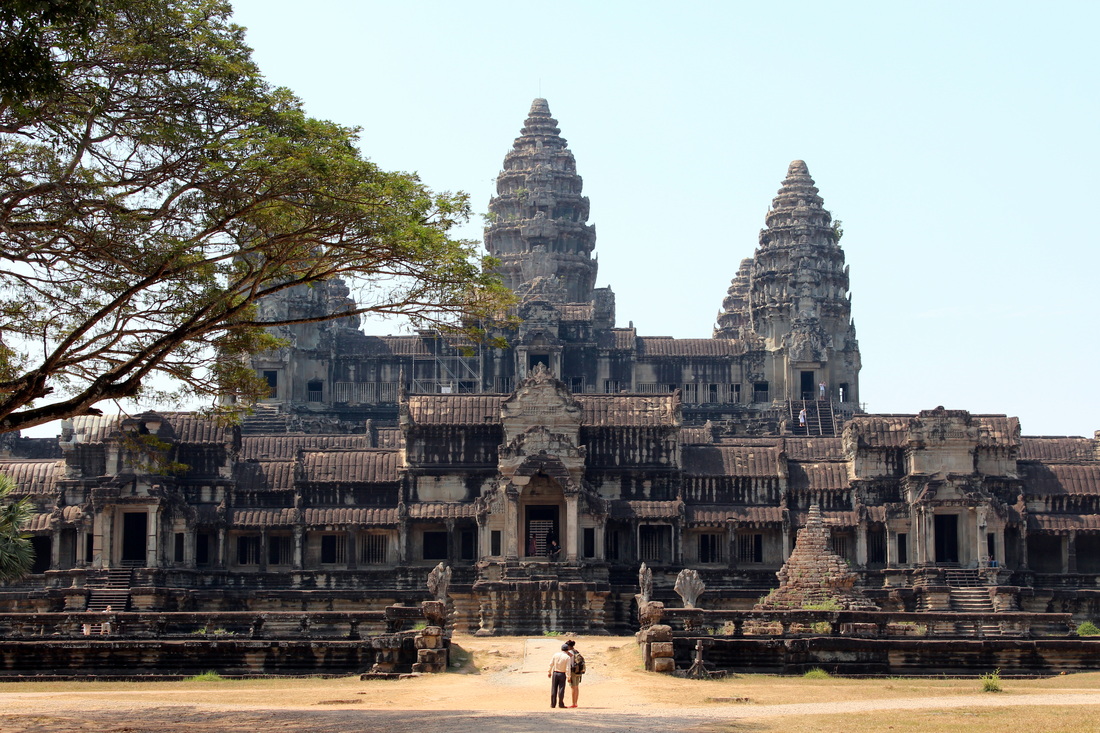



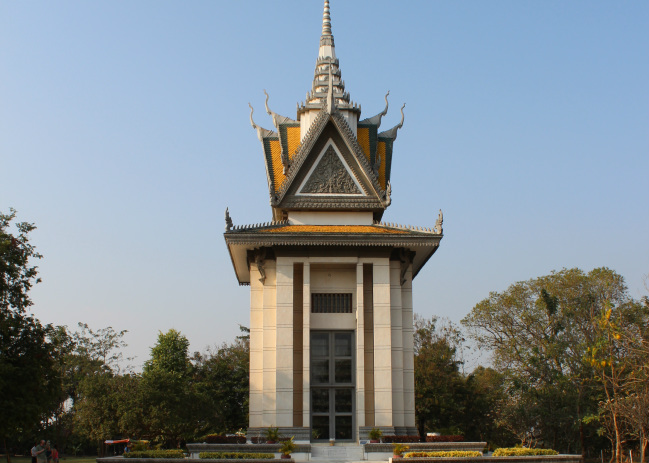













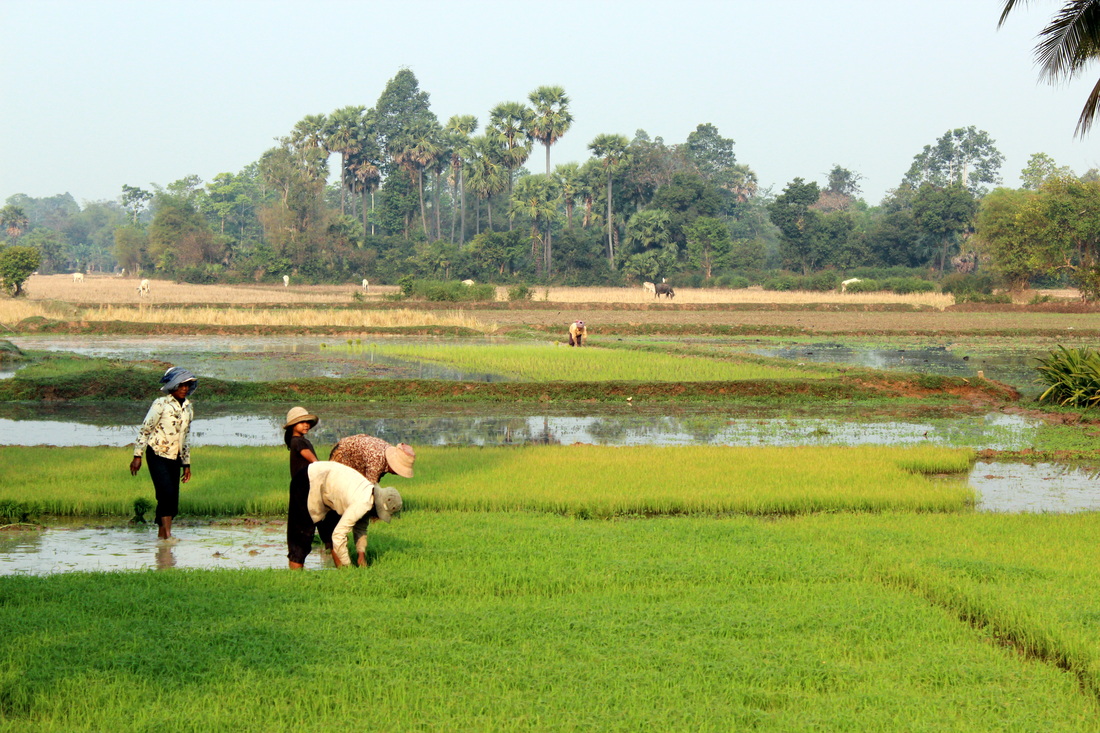































































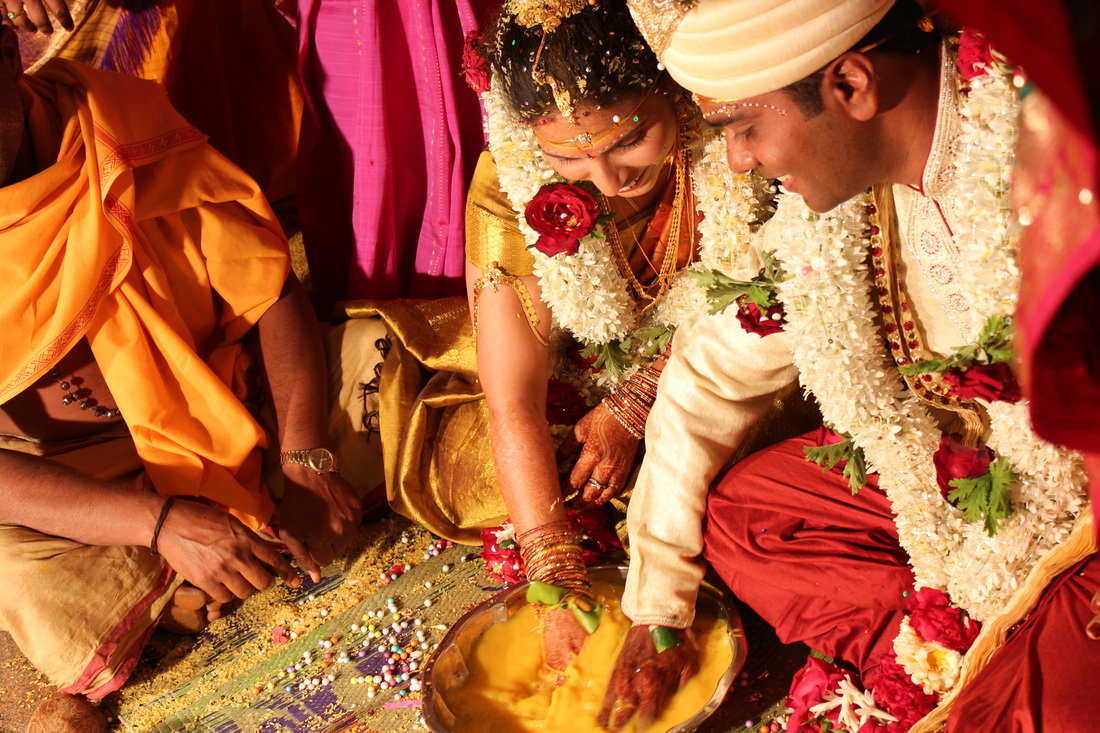
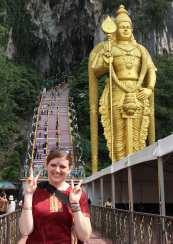
 RSS Feed
RSS Feed